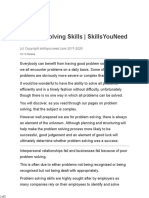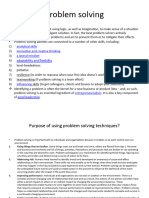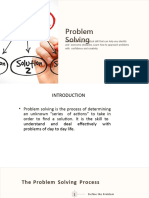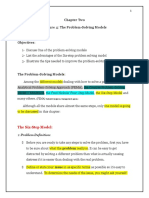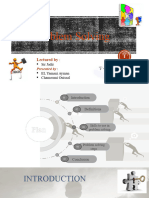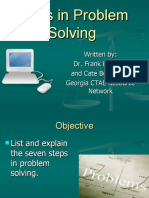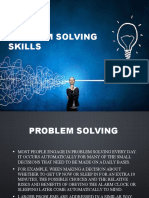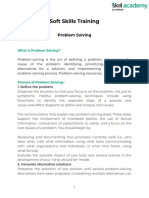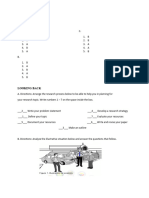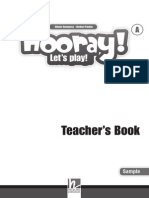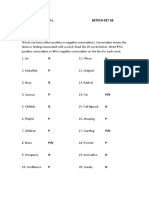Workbook 8
Problem solving
A self-help guide
Revised 03/2022 v1
� Contents of
this booklet
What can problem solving do for me?................................3
When could I use problem solving?....................................4
Problem solving……………………………………………….5
Problem solving – the six steps……………………………...6
Notes………………………………………………………….14
Further resources……………………………………………15
Useful contacts……………………………………………....16
As you work through the booklet, feel free to make notes
on the pages and use the “Notes” page near the back.
2
�What can problem solving do for me?
Problem solving
Problems and obstacles appear constantly in our lives and we all
have different problem solving abilities.
Some people are better at solving problems in certain areas of their lives than others.
Some problems or obstacles that come up can be more difficult to solve than others.
Meanwhile, others may leave us feeling overwhelmed and helpless.
The ability to problem solve effectively has the following benefits:
• Improves how we manage and control our feelings
• Enhances ability to cope with a variety of stressful situations
• Helps protect against common emotional problems such as stress, worry,
depression and anxiety
• Can help us to feel more optimistic and hopeful
• Develops flexibility in the way we think about problems and our ability to
implement solutions.
Tabletop metaphor
Think of a table and imagine the tabletop is you and your existing
coping strategies and the table legs are the aspects in your life that
you have to support you (e.g. supportive boss, family you can talk to).
If the tabletop or legs are weak then the table will not be able to support much weight
and will break if you put too much pressure on it (stressors). If you can strengthen the
tabletop or legs then it will be able to support more weight.
By using effective problem solving, we are strengthening our coping style and ability.
This means we will be able to cope when stress is added.
Reflect
Consider what problem(s) you may be
experiencing currently in your life that you may
be able to resolve through problem solving.
3
� When could I use problem solving?
Finding solutions
Problem solving can be used any time you
have a problem or difficulty and need to come
up with a solution.
It could be used to tackle anything from a life changing
decision like which house to buy or which job to take, to
what you should do at the weekend.
Low mood, anxiety and stress all have an impact on our
ability to problem solve and sometimes the way we are
feeling and our emotions make it difficult to make decisions.
The problem solving technique described in this workbook
provides a useful tool which should help us to work through
a problem and come up with a solution objectively.
Achieving goals
Problem solving can also help you to achieve
goals you set yourself as you can use the
techniques to overcome obstacles that may get
in your way.
The steps in this workbook should allow you to work
through different options to help you to come to the best
possible solution. By committing to a decision, worry and
stress should reduce and we should feel more hopeful. We
want to be able to think creatively of a variety of ideas, not
just a few. For this we use brainstorming which helps to
increase our flexibility and creativity. It also helps us
concentrate energy on solving the task (“How can I go
forward?”) rather than negative emotions and thoughts
(“Why does everything go wrong?”).
Reflect
Consider how you have currently been managing
your problems.
4
�Problem solving
The six steps
The next few pages of this workbook will guide you through the six steps of problem
solving.
Step 1 – Write down the problem
Step 2 – Write down as many solutions as you can think of
Step 3 – Decide which solution is most effective
Step 4 – Choose a solution
Step 5 – Create an action plan
Step 6 – Evaluate
5
� Problem solving - the six steps
Step 1: Write down the problem
The problem is…
Can this problem be changed? Based on your answer, what is your
major goal? Remember to be realistic.
What are some barriers to this goal? (obstacles, conflicting goals,
reduced resources, unknown/unfamiliar, complexity, emotional
difficulties)
• Be specific, describe who, what, when, where, how and why. The more specific
you are about what the problem is, the more likely it is that you will find a workable
solution. For example, rather than writing ‘financial problems’ you might put ‘I have
£3000 of credit card debts’.
• User clear language and only facts, not assumptions.
• If the problem is large, break it down into smaller ones and develop a series of
“mini goals”.
6
� Problem solving - the six steps
Step 2: Write out as many solutions as you can think of
Quantity principle – quantity leads to quality
It is more important to get many solutions as this increases your chances of eventually
identifying high-quality alternatives. If you wanted to buy a shirt in a specific size and style,
then a large shop with more variety is more likely to have the one that suits your
preferences. Remember that it’s important to write down your list of ideas.
Deferment principle – do not judge the solutions
Record every idea that comes to mind to increase the number of ideas. If you reject ideas
it will limit your creative thinking. If an idea seems silly or unrealistic it can spark another
possible idea. Alternatively, two ideas that initially seemed weak could merge to generate a
reasonable idea. The only rule is that the ideas should be relevant to the problem. If you
notice yourself judging the ideas tell yourself to “stop” and remind yourself that it will cut
down creativity.
Think of strategies and tactics – greater variety for better quality ideas
• Strategies – general courses of action you can take
• Tactics – specific steps to put a strategy into action
Look over your list, identify the strategies and group the alternative solutions into common
themes. If any strategies have few specific tactics, try to generate more. Try to think of
more strategies and more new tactics for those strategies.
Even the most ridiculous solutions should be
considered. Even if you know you won’t choose
this option, it helps to get you thinking about your
problem creatively.
7
� Solutions:
If you get stuck and cannot think of many alternatives try the following to
help stimulate creativity:
• What would someone else do? This could be anyone. It could be someone
you admire like the Dalai Lama, a character from a television programme, a
soldier, a relative or a sports hero, from Simon Cowell to Kermit the Frog:
What advice would they give you?
• Use visualisation, imagine the problem and see yourself attempting to cope
with it and achieving your aim. Think about different ways to reach that aim.
When using visualisation, notice the situation and what you are feeling,
thinking and doing. Visualisation is a useful technique that can be used to
predict obstacles, find solutions and gain hope.
• Combine ideas or modify them to improve ideas or come up with new ones.
• Take a break if you experience a block, go away from the task and come back
a couple of hours later.
8
�Problem solving – the six steps
Step 3: Decide which solution is most effective
Go back to the solutions list and cross out any that are “obviously” ineffective. Re-write the “top” 3-5 below and note several
positive and negative consequences (personal, social, short-term, long-term) for each. Then rate the solution using a scale of 1
(ineffective) to 10 (very effective). As you rate these ideas, can you think of any other alternatives?
Rating
Solution Advantages Disadvantages
1-10
� Problem solving - the six steps
Step 4: Choose a solution
Identify the solutions you rated highly (that is those greater than six). If none were
rated this high, try to generate a few more and continue the process.
If there are a few ideas rated at least a six ask yourself if you think you can actually
carry them out. If “yes”, include these ideas as part of your overall action plan. If not,
identify other potentially effective solutions and continue this process.
Chosen solution
10
�Problem solving - the six steps
Step 5: Action plan
What will you do?
How will you do it?
Do you need anyone else to be involved? Consider how you will
arrange this (i.e. what their commitments / schedule is like)
When will you carry out your plan?
11
� Problem solving - the six steps
Step 5: Action plan continued…
Any concerns about the plan
Things to consider
Are there any changes you would like to make to this action plan?
Also note any concerns you might have about carrying it out optimally – Do you think
implementing your plan might be a problem in itself? If so, problem solve it!
Make sure that your solution is SMART:
• Specific – what, when, where, with who?
• Measurable – how will you know you have completed this activity?
• Achievable – do you have everything you need to achieve this?
• Realistic – is it realistic?
• Time-focused – what time, what day, for how long?
12
�Problem solving - the six steps
Step 6: Evaluate
What happened after you carried out your action plan? (Can include
various personal, social, short-term, and long-term consequences
that occurred if appropriate)
How would you rate your overall satisfaction? Consider effects on
others as well as yourself
1 2 3 4 5 6 7 8 9 10
Not satisfied Very
at all satisfied
Reflect
Was the problem resolved to your satisfaction?
If YES: reward yourself!
…and remember to practice, practice, practice!
If NO: go back through the steps and decide what needs to be changed and why
the previous solution did not work.
…did you identify obstacles, generate ideas, make the goal realistic, predict
consequences, carry out the plan?
13
� Notes
………………………………………………………………………………………
………………………………………………………………………………………
………………………………………………………………………………………
………………………………………………………………………………………
………………………………………………………………………………………
………………………………………………………………………………………
………………………………………………………………………………………
………………………………………………………………………………………
………………………………………………………………………………………
………………………………………………………………………………………
………………………………………………………………………………………
………………………………………………………………………………………
………………………………………………………………………………………
………………………………………………………………………………………
………………………………………………………………………………………
………………………………………………………………………………………
………………………………………………………………………………………
………………………………………………………………………………………
………………………………………………………………………………..........
14
�Further resources
Workbooks
Centre for Clinical Interventions (CCI) – https://www.cci.health.wa.gov.au/
A range of detailed resources and PDF workbooks available to download for free
focusing on a range of depression and anxiety related difficulties.
Northumberland, Tyne and Wear NHS – https://web.ntw.nhs.uk/selfhelp/
Self-help guides free to download by PDF and print on a range of difficulties including
anxiety and depression.
Smartphone apps (found on Apple and Google Play store)
WRAP – Wellness recovery action app
Mood Tools – Depression aid
Fear Tools – Anxiety kit
Insight Timer – Meditation app
Websites
Mind – https://www.mind.org.uk/
Mental Health Foundation – https://www.mentalhealth.org.uk/
NHS – https://www.nhs.uk/mental-health/
15






